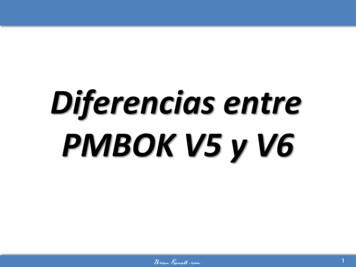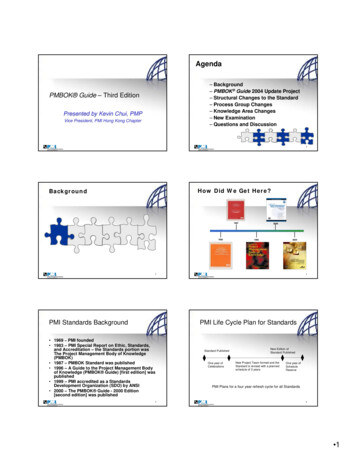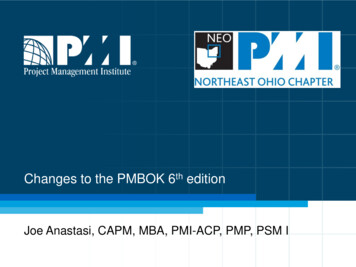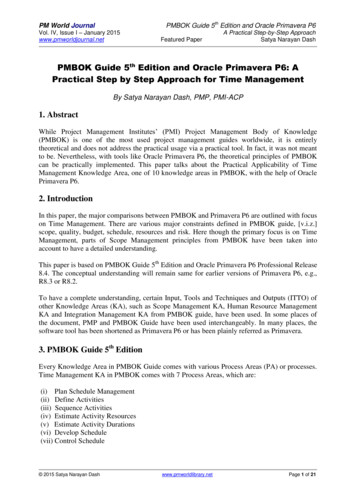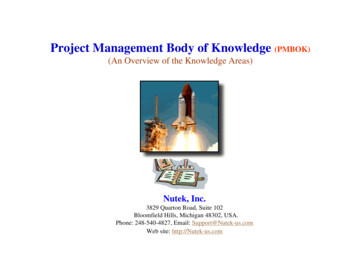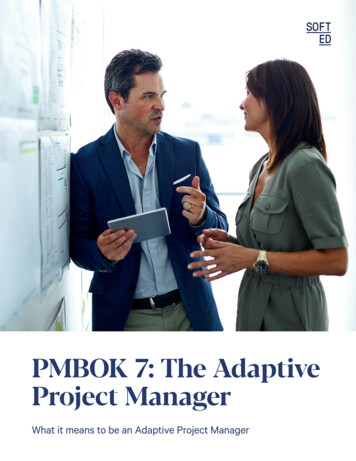
Transcription
PMBOK 7: The AdaptiveProject ManagerWhat it means to be an Adaptive Project Manager
StructureThe PMBOK 7 or formally “A Guide to the Project Management Body of Knowledge(PMBOK Guide) – Seventh Edition and The Standard for Project Management” documentstructure departs from the former prescriptive or “how” direction and defines an Agile-likePMI “manifesto” of principles dealing with “what” and “why”. While the historical input/output process and compliance models do not disappear entirely, the major emphasis isshifted from deliverable-forward Process Knowledge Areas to Project Performance Domainsfocused on overall outcomes.To reflect this change, the book is divided into 2 sections:OverviewThis whitepaper examines what it meansto be an Adaptive Project Manager (APM)through the lens of the Project ManagementInstitute’s Guide to the Project ManagementBook of Knowledge, Seventh Edition (PMBOK7). But before we get into the details, abrief discussion of how the new PMBOK 7is different from previous versions will helpto provide important context necessary tounderstand how it supports an adaptiveapproach without abandoning its prescriptiveroots. the “The Standard for Project Management”, the ANSI approved content (what mostpeople think of as “traditional” project management, with prescriptive and detailedinstructions) and “A Guide to the Project Management Body of Knowledge” containing the “new”principle-based framework for applying all or parts of the standard. While the frameworksection is new to the document, the concepts and techniques have been around fordecades.Here’s a content summary of the major differences between the two latest versions:PMBOK 6PMBOK 7Prescriptive – follow these stepsPrincipled – use these ideasPredictive approaches onlyMix of approachesProcess oriented knowledge areasPerformance oriented project domainsDeliverable and technique focusedOutcome focusedRecognition of tailoringGuidance for how to tailorTarget audience: project managersTarget audience: any project stakeholderIt should be noted that while there are significant differences affecting how a projectmanager might do their jobs between the two versions, the PMI is not abandoningpredictive techniques. Far from it.But what they are recognizing is that given today’s environment, there are many differentways to achieve success. And those methods are best explained by their underlying andsomewhat fluid concepts, versus a rigid set of steps or activities.Copyright Software Education Holdings Ltd, 20212Copyright Software Education Holdings Ltd, 20213
What is AdaptiveLeadership?The term “adaptive leadership” was coined by psychiatrist RonaldHeifetz in his 1998 book “Leadership Without Easy Answers”. Althoughthe concept “adaptive management” applied to a business environment(in contrast with ecological practices using the same concepts in usefor thousands of years) it has its roots in the scientific managementideas put forward by Frederick Taylor in the early 1900s.In other words, successful, long livedspecies and organizations are ableto thrive over time by taking the bestfrom their history into the future. Butthese characteristics, in biology andorganizations, are not applied all at onceor only in one place. Beyond the obvious“building on the past” analogy, Heifetzhighlights several other biology-inspiredconditions that promote thriving throughadaptation:From a contemporary review of Heifetz’s book, the Library Journalprovides the best summary of what adaptive leadership is all about:“ to approach problems as adaptive challenges bydiagnosing the situation in light of the values involvedand avoiding authoritative solutions, to regulate thelevel of stress caused by confronting issues, and to shiftresponsibility for problems from the leader to all theprimary stakeholders.”accurately analyze issues within their respective contexts empathize and understand those who will feel a sense of loss fromanticipated changes involve critical stakeholders in broader ways to embraceaccountability for solutions and outcomesCopyright Software Education Holdings Ltd, 2021 Loss TimeLoss is an ever-present component inevolution as sub-optimal pieces are shedor changed. But unlike nature, loss is feltby people when confronted by change.This is why empathy toward those whoare, or will be, experiencing loss is a criticalcomponent that must be employed ifadaption is to be successful.Heifetz, et al, in part, base their theories on characteristics thatevolutionary biologists say are necessary for a species to thrive:2. DNA notsupporting survivalis either discardedor reregulatedDiversityIn nature, diversity abounds. With people,diversity allows organizations (or entities)to leverage many different perspectivesand alternatives. From diversity comesunique and sometimes counter-intuitiveimprovements, not present in cloned orduplicated structures, processes or roles.The techniques evolve from the definition that the authors offer:“Adaptive leadership is the practice of mobilizing people to tackletough challenges and thrive.” Thrive is an important word. Here’s why.1. Over time, the coreDNA of a species,the basic buildingblocks necessaryfor survival, ispreservedExperimentation Experimentation is just that. The onlyway to know if something is working is toexperiment and compare the results. Eachchange for the better is kept. Changes forthe worse are discarded. Improvisation iskey.Heifetz’s 2008 follow-up, with co-authors Alexander Grashow andMarty Linksy, “The Practice of Adaptive Leadership” expands on earlierworks by providing tools and techniques to: Time is the final condition. Evolution doesnot happen overnight or by the end of thequarter. And while some changes can beaccelerated, lasting change, built on priorexperiments with diverse populations takestime to formulate, incubate, hatch andgrow.3. The remainingDNA isreorganized toallow the speciesto flourish in newways and newenvironmentsFor the adaptive leader to succeed, thatis to mobilize people to conquer difficultor complex challenges and doing it so thepeople and organization thrive, takes amindset and tool chest that veer sharplyfrom pure authority-based, command andcontrol behavior.4Copyright Software Education Holdings Ltd, 20215
Why is Adaptive ProjectManagement a good thing?Organizationally, project or initiative management is a micro application of the larger entityfocused macro leadership associated with executive suites and upper management layers.Though the scope of effect is not the same, both share a fundamental goal: get people to dothings that may or may not be in their best self-interests. For the project manager, this goalcan be a daily challenge to accomplish. Project management using an adaptive leadershipmindset and techniques can not only make the goal more easily achievable, but with greatervalue for all involved.One of the top reasons why adopting an adaptive approach to project management is agood thing lies in its inherent separation of issues requiring technical solutions versusthose in need of an adaptive approach. While adaptive techniques can be used to solvetechnical problems, it is rare to see an adaptive challenge addressed successfully with atechnical fix. Practically speaking, the differences between the two are straightforward asshown in the table below (adapted from Ronald A. Heifetz & Donald L. Laurie’s “The Work ofLeadership”):Technical ProblemsAdaptive ChallengesReadily observable. Easy to recognize.Often obscure. Difficult to identify. Easy tooverlook.Normally lend themselves to known,previously used solutions.Require holistic changes to solve. Changesto roles, relationships, values and howthings are done.Typically can be solved by a subjectmatter expert or arbitrarily by authority.Those with the problem are tasked to dothe work of solving it.Limited changes required; mostly insideorganizational boundaries.Multiple changes required; often crossingorganizational boundaries.People are largely pre-disposed andwelcoming to technical solutions.People commonly reject the notion that anadaptive challenge even exists.Quick solutions can often be deployed,sometimes by edict.Can’t be edict-driven; requiresexperimentation; often takes perceptiblylonger to implement.By providing the project manager with a way to recognize and articulate the difference betweentechnical problems and adaptive challenges, time and effort can be more effectively and efficientlybe prioritized. At the very least it provides a discussion framework that can be instrumental inachieving a positive outcome.Here are some examples of problems and possible solutions further highlighting thedifferences:Problem/IssueTechnical SolutionAdaptive SolutionRising rates of diabetesMore and different drugsLifestyle changes arounddiet and exerciseAnother reason why adaptive project management is a good thing rests on the fact that oneperson can’t nor should be the “go-to” subject matter expert on all topics that impact an initiative.Adaptive project management removes the leader from that role, freeing them to concentrate onsupporting other aspects of the initiative.Finally, adaptive project management provides a foundation of flexibility. By using a principledbased approach, project managers are free (within their operational environments) to pick thosetools artifacts and methods that make the most sense to reliably achieve a desired outcome. Thismakes it useful across any functional area in any industry segment.Increasing truancy in public Geo-location trackers linked Raising public awarenessschoolsto law enforcementof the personal and publiccosts and risks truancyrepresentsBias leading to missed hiring AI-based resume reviewopportunitiesintegrated with publicrecord analysisCopyright Software Education Holdings Ltd, 2021Sensitivity training toheighten awareness,combined with penalties forbad behavior6Copyright Software Education Holdings Ltd, 20217
“The single mostimportant skill andmost undervaluedcapacity for exercisingadaptive leadership isdiagnosis.”Heifetz, et al, “The Practice of Adaptive Leadership”What is an Adaptive ProjectManager (APM)?An APM is a project manager who is not wed to a single method, technique or artifact justbecause it was useful on the last project they managed. They are focused more on what ittakes to provide value than on delivering things of questionable worth. If given the choicebetween working on assembling data for a routine status report and spending time with acustomer to get a better understanding of their expectations, an APM would choose thelatter, rather than the former.APMs are mindful of the environment they operate in. They know reaching a successfuloutcome is less about what they do as individuals and more about how the stakeholdersthey interact with contribute, and sometimes detract from, the overall goal. Theyunderstand that for many outcomes, organizational success also means some people,required for that success to happen, will be negatively impacted. Rather than ignoring thatfact (and those people), APMs use empathy to grasp the extent of the impact and engagethose people in an effort to lessen what is often perceived as a sense of loss.APMs develop deep understanding of how issues and problems manifest. They can tellthe difference between problems that can be solved by using technical or subject matterexpertise, and those that need a different approach. This is a critical skill. Heifetz, et al,in “The Practice of Adaptive Leadership” say “The single most important skill and mostundervalued capacity for exercising adaptive leadership is diagnosis.”Copyright Software Education Holdings Ltd, 20218Copyright Software Education Holdings Ltd, 20219
The first thing is anemphasis on flexibility.By adding an entirely new companion“guide” based on principles ratherthan processes, the current PMBOKencourages a thoughtful approach toproject management rather than onesingularly focused on executing a specificmethod.If your idea of project management isrooted in “doing things by the book”(and there is only one book), youwill need to disabuse yourself of thisbelief.How does PMBOK 7help transition from a“traditional” PM to anAPM?Copyright Software Education Holdings Ltd, 2021Next, while so-called predictive orwaterfall methods are still appropriatefor a large number of projects, especiallyin business sectors where the agilemantra of “fail fast” is not always anoption (think construction or financialservices), the ability to deal with rapidand often unforeseen changes requires adifferent mindset and collection of skillsand techniques. Recognizing this reality,PMBOK 7’s focus shifts from deliverablesto outcomes, although some maycorrectly argue that outcomes are notpossible without deliverables.PMBOK 7 touches on many of the things thatare needed to be an adaptive leader in today’sworld of volatility, uncertainty, chaos andambiguity; commonly acronymized to VUCA.Included with the emphasis on outcomesis the recasting of project managementas a key component of a “Value DeliverySystem”. What is a Value Delivery System?The wealth of information contained in PMBOKis enormous, whether you are adaptive, agile,predictive or a mixture when it comes to your(or your organization’s) approach to projectmanagement. And if you aspire to be “adaptive”you can, and should, pick and choose thosepieces which make the most sense to you,given the context of where you are applyingyour project management skills. However, thereare a few things in the PMBOK you need to fullyembrace to become truly adaptive.10“A business is a value delivery system”,says the title of a staff paper by McKinseyconsultants Lanning and Michaels in 1988,which extended the notion of advancingappropriate value propositions at eachCopyright Software Education Holdings Ltd, 2021stage of production and distributionthroughout the entire enterprise. AdaptiveProject Managers use this construct as atouchstone to maintain alignment to whatis important.When new requirements appearor changes to completed work arerequested, APMs look to what value isbeing created or enhanced before blindlyforging ahead.So the ability for the APM to recognizewhere, when and how value is beingcreated and delivered is a good thing.It benefits the entity and the individual.But recognition alone is not enough. TheAPM must be mindful and deliberate intheir actions relative to the Value DeliverySystem they find themselves involvedwith.PMBOK 7 also contains new sectionson “tailoring” and models, methodsand artifacts. From a practitionersperspective, this collection of tools isperhaps the most welcome and usefuladdition to the document. These sectionsoffer ways and means to adopt anypractice that fits the situation at hand.Of course PMBOK 7 has many more usefulpieces that deal with specific techniquesand expansions on their 12 principles andDomain Performance Areas. APMs canfind much relevant content in this bookSo whether you are a PMI member or not,if you are looking to up your PM game,you won’t go wrong getting a copy ofPMBOK 7.11
Why training is the fastestway to become an APM?By definition, being adaptive means dealing with challenges; challenging yourself andchallenging others. Most of us find it difficult to challenge ourselves for obvious reasons.It’s hard and can be painful. Likewise, challenging others can be both difficult anduncomfortable.Training can help overcome the pain and discomfort by providing a number of useful things:1. A safe environment forexpression and questions2. Compressed situationalguidance in the form oftools and techniques3. Objective feedback forimprovementThe alternative is to assemble the relevant research and develop your own set of tools.But you will still be faced with trying to objectively give yourself feedback. That could takeyears.You are encouraged to explore the SoftEd library of courses and material to help you onyour journey.Copyright Software Education Holdings Ltd, 202112Copyright Software Education Holdings Ltd, 202113
New ZealandAustraliaAsiaUSA0800 268 7731800 145 152 65 6408 37611800 268 0390Copyright Software Education Holdings Ltd, 2021www.softed.cominfo@softed.com Software Education Holdings Ltd.14
The PMBOK 7 or formally "A Guide to the Project Management Body of Knowledge (PMBOK Guide) - Seventh Edition and The Standard for Project Management" document structure departs from the former prescriptive or "how" direction and defines an Agile-like PMI "manifesto" of principles dealing with "what" and "why".
